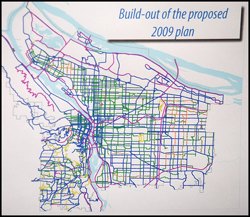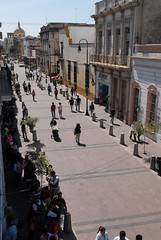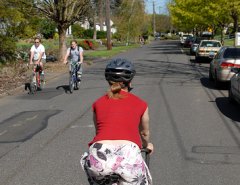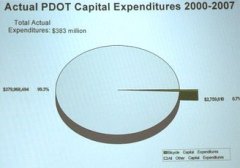
If you have something to say about the Portland Bicycle Plan for 2030 (a.k.a. the Bicycle Master Plan), Sunday (11/8) is your last chance to do it.
PBOT will take all comments received by Sunday night and try to work them into revisions of the Plan before it is finalized and goes in front of City Council for official adoption on January 20th (you can also show up to City Hall to testify on that day).
The 118 page Plan (download the whole thing or parts of it here) was over two years in the making and it will help dictate how our bikeway network is built out for the next 20 years.
So far, it has been generally well-supported, but we have also heard some criticisms and suggestions on how to make it better.
Off-street trail advocates have made their voices heard, calling on PBOT to put more emphasis and priority on facilities like the yet-to-be-built Sullivan’s Gulch and North Portland Greenway trails.

enough to lead to carfree districts
like this one in Guadalajara?
(Photos © J. Maus)
We’re likely to see some revisions in the plan to acknowledge their input, but for PBOT, these trail plans are simply not developed enough (yet) to warrant higher priority. Sullivan’s Gulch goes through right-of-way that is owned by a railroad company that is under no obligation to relinquish it. It is also extremely expensive from PBOT’s budget-strapped perspective, costing an estimated $7.7 million per mile.
Trails are also not PBOT’s jurisdiction. Even though they are increasingly considered as transportation corridors, off-street paths are managed by the Parks Bureau. This lack of a clear champion within the bureaucracy is a rightful concern of trail advocates.
On a similar note, others have said the plan focuses too much on bicycle boulevards and should instead create a network of cycle tracks on main streets and in commercial districts.

PBOT likes cycle tracks, but they don’t think the political will exists yet to be aggressively implement them. Cycle tracks are expensive and require tricky political balancing acts like removing parking and motor vehicle lanes in dense commercial zones (where business owners have traditionally been difficult to win over). For PBOT, cycle tracks aren’t just politically difficult, they are also not fully embraced by “the bike community” they are meant to serve, and it’s much easier for PBOT to do bike projects that have overwhelming support.
Instead of getting too far out in front with cycle tracks, PBOT wants to “build the constituency” with bike boulevards (not like the pseudo-boulevards we have today, but real, developed bike streets where it’s obvious that bike traffic has been prioritized — like we hope the ones being built on on SE Spokane and N Going Streets will turn out).
According to PBOT, the bike boulevards will lead to higher bike usage, which will then build the constituency necessary to push for more bold and difficult treatments like cycle tracks.
In a blog post last night, local transportation thinker (and Planning Commissioner) Chris Smith refers to this debate about bike boulevards and cycle tracks as either going “broad or deep”.
I think it’s a mistake to see this as an either/or situation. Obviously, given that they’ve already installed one cycle track downtown, the City is keen on doing more of them and I’d be shocked if we don’t new ones pop up soon (or, more likely, see the PSU/Broadway one extended). So, while the plan puts an emphasis on bicycle boulevards, it’s likely that PBOT will take a flexible approach as funding opportunities arise.
But will those opportunities arise? Is PBOT going to put their money where their mouths are?

PBOT spends on bikes.
The Portland Mercury published a feature story this week drawing attention to the fact that while the plan looks to make bicycles a “pillar” of the transportation system, it still only commits about 1% of it’s budget to funding them.
The Bicycle Transportation Alliance (BTA), Portland’s largest bike advocacy organization, is in support of the plan. They haven’t made their official comments public yet, but staffer Michelle Poyourow testified at the Planning Commission hearing on October 28th.
In that testimony, the BTA said they find the Plan’s “goals, objectives and action items to be strong”. However, they warned the Commission that those goals could only be reached if the policy proposals made by PBOT in the Plan are “explicitly — not just implicitly” incorporated into other important City planning documents.
“Create conditions that make bicycling more attractive than driving for trips of three miles or less.”
— PBOT’s proposed new language for the City’s policy on Bicycle Transportation
That’s the big win for the Bike Master Plan. There’s little doubt it will be adopted by Council; but the real victory for PBOT is if the policy recommendations in the Plan become codified into the City’s much more powerful and binding Transportation System Plan and over-arching Portland Plan. These recommendations include things like the “green transportation hierarchy” which could lead to policies to establish carfree or “car-limited zones”, planning models that favor the movement of people instead of the movement of cars (like they currently do), and so on.
The Plan also proposes a change to the City’s official policy on on Bicycle Transportation (Policy 6.23 in the Transportation System Plan) to “Create conditions that make bicycling more attractive than driving for trips of three miles or less”.
That statement is much stronger than the current one, which only refers encouraging bicycle use and making it “a part of daily life” in Portland. If adopted as official policy, it will be a much more powerful lever to advocate for bikeways.
The BTA’s Poyourow says she’s also concerned that the plan doesn’t have enough specific benchmarks. The over-arching goal of the plan is to have 25% bike mode split by 2030, but Poyourow would like to see intermediate goals to make sure the plan stays on course.
Given the current trajectory for bicycle use and funding opportunities (thanks to a regional government (Metro) and an Obama administration that cares about livable communities), it seems like 25% by 2030 isn’t all that bold. Wouldn’t we reach that amount of bike use just by continuing on our current path of projects, policies and programs?
Portland needs a plan that we can all get excited about. 21 years nothing for planners, but for the public I worry that it seems too far off. I also worry that it doesn’t hold politicians and policy-makers accountable enough since they’ll all be long gone by the time 2030 rolls around.
I’d love to see the BTA or some other organization get behind another bike plan that focuses more on activating a groundswell of grassroots, public support of bicycling. How about a campaign called 20/15 that shoots for 20% mode split by 2015? It’s an exciting mode split number and a date that is much more real to most people.
Whatever you think about the Plan, let PBOT know! Public comment period ends this Sunday.
And remember, regardless of whether or not you agree with the strategy or policies, we are very lucky to have an amazing group of PBOT employees and volunteers who have spent two years of hard work putting together the most in-depth and forward-thinking bicycle plan any city has ever seen.

